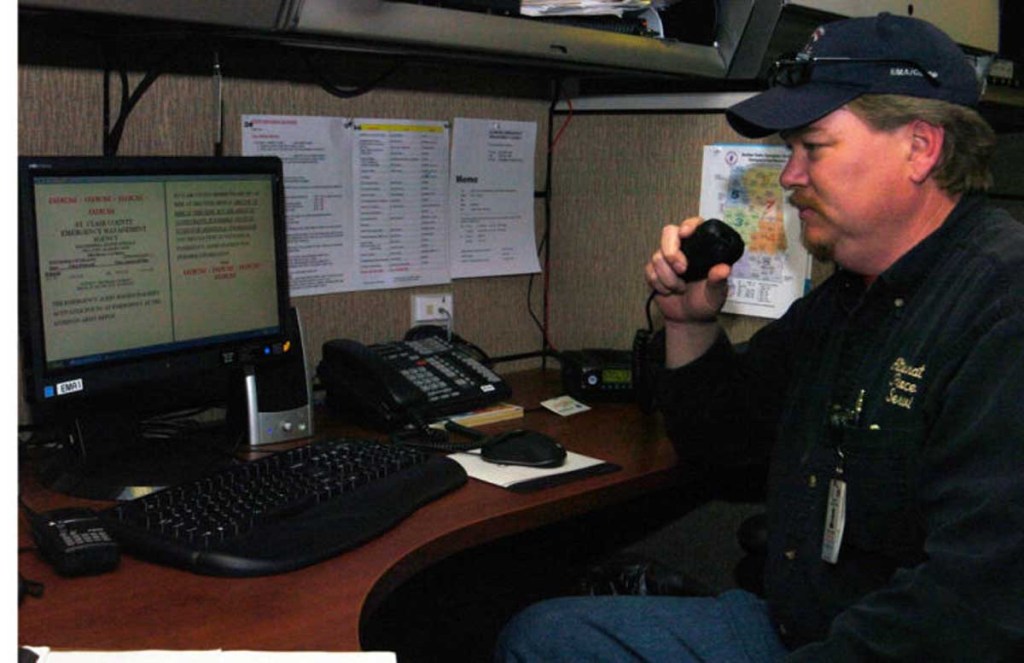On call
Published 2:10 pm Thursday, March 25, 2010

- ARES coordinator Steve Ayres relays messages to evacuation shelters in a mock drill.
County, state, and federal evaluators were “very pleased” with local emergency services during a recent annual exercise, according to St. Clair County’s Emergency Management planner.
Trending
“We got a lot of accolades, and that’s always good to hear,” said Bryan Schaefers of the county Emergency Management Agency (EMA).
The yearly emergency simulation was part of the Chemical Stockpile Emergency Preparedness Program (CSEPP) and involved local fire departments, the Red Cross, the Department of Human Resources, amateur radio operators, and law enforcement, public health, and public works agencies.
“We had a great cooperation at all levels from all disciplines,” said Ellen Haynes, EMA director. All 10 cities and towns in St. Clair County were involved, and everyone came together with a singleness of purpose.”
Ms. Haynes added that an annual CSEPP exercise may no longer be mandated, but local quarterly exercises will still be conducted to prepare for a chemical or weather emergency or other natural disaster. “We’re in the business of being ready.”
The exercise simulated an escalating chemical emergency involving a blister agent at the Anniston Army Depot. It began as a Level 2 limited area situation at the chemical storage facility and advanced to a Level 3 designation, which means that a chemical release is not expected to present a danger to the public outside of the depot. Within 10 minutes, it had escalated to a Level 4 affecting the surrounding community.
Schaefers said that, although the Emergency Alert System was activated and a state or emergency was declared, St. Clair County residents were never in actual danger, nor was the area directly threatened as part of the exercise. Four shelters were set up in Cropwell, Pell City, Springville, and Moody to accommodate Calhoun County evacuees. Long-term housing is not likely to be offered locally in a real emergency, Ms. Haynes said, although EMA officials would direct evacuees to resources in other areas.
Members of local Amateur Radio Emergency Services and Radio Amateur Civil Emergency Services (ARES/RACES) were involved in relaying information to and from emergency shelters.
Using mobile technology that allows them to broadcast when power and other communications services are not available, the ham operators become the area’s eyes and ears, according to Steve Ayres, emergency director of the 55-member local volunteer group.
“We have a lot of tools in the box we can use for different events and situations,” he said. “For example, if this had been a real event, there would likely be sensitive information, which you might not want to send over the air because anybody could pick it up, that may need to relayed to a particular location. We’re able to broadcast that information as a ‘packet,’ which is like an email over the air, so that only the intended person can receive it.”
Ayres has been involved with ARES/RACES for 11 years and said that it is not a club. “It’s a group of guys who want to serve the county through emergency radio services. We make the investment and provide our own equipment, but the EMA has been very good to us. Everybody wants to be like St. Clair County’s emergency services.”
Amateur radio operators also play a role in storm spotting when severe weather threatens. “Sometimes I think we watch conditions more closely than the National Weather Service,” said Tom Randall, the group’s assistant emergency coordinator. “We keep track of storms as they come out of other states and monitor them as they get closer to where we are.”
“Whatever the emergency is, we want to play a part in making sure no one gets hurt,” Ayes said. “You can buy a new house, a new car, or new clothes, but you can’t buy a new mom or dad.”
That’s the kind of local cooperation that’s essential in an emergency situation, Ms. Haynes said.
“All disasters are local. The local people have a stake in what happens. (The EMA) is going to be here before, during and, after an emergency. It means a lot to us to make sure folks affected by a disaster recover from it.”


